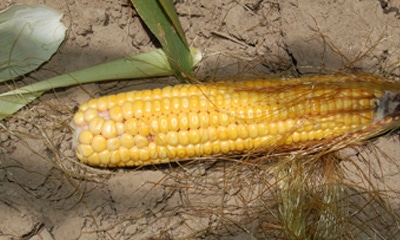
How corn kernels mature is nothing short of amazing. Dave Nanda, a crops consultant who works with Seed Consultants Inc., sponsor of Crop Watch ’16, says it helps to understand the corn plant’s purpose as you follow ear development during the final growth stages of the season.

MOVE TOWARD MATURITY: Kernels on every ear move through a development process as corn matures. Read on to learn what’s next for ears like this one.
“The plant has one goal, and that is to create as many viable progeny as possible,” Nanda says. “I like to say the corn plant wants to make as many babies as it can. We grow hybrids and the seed won’t be replanted, but the individual corn plant doesn’t know that. Each plant is geared to produce as much seed as possible. It’s not about filling your grain tank and making you more profit. It’s about providing for the next generation."
Here are five key stages that occur during grain fill. Agronomists have classified these stages of growth so they can discuss corn development on a more scientific basis. These descriptions rely heavily on information available in the Purdue University Corn and Soybean Field Guide, 2016 edition. It’s prepared by the Purdue Crop Diagnostic Training and Research Center. Purdue agronomist Corey Gerber is in charge of the center.
1. R2 or blister stage
The ear pictured above is well beyond this stage. The blister stage occurs 10 to 14 days after silking. Developing kernels are translucent white "blisters" on the cob, containing a sugary, white fluid.
Starch is just beginning to accumulate in the endosperm of the kernel. The first parts of the baby plant have formed within the embryo in the kernel. Moisture content is about 85%. Kernels can easily abort at this stage if the plant sends signals that conditions are not favorable, and it needs to cut back on the number of kernels it will try to finish.
2. R3 or milk stage
Kernels typically reach this stage 18 to 22 days after silking. Ears of some late-planted fields could be in this stage. Kernels can be yellow or white, and contain a milky, white, sugary fluid. This is the "roasting ear" stage, if you think in terms of sweet corn.
Moisture content is still about 80%, and severe stress can still cause kernel abortion at this stage.
3. R4 or dough stage
Kernels are 24 to 28 days past silking. The contents inside the kernel now have a pasty appearance. Starch accumulation continues in the endosperm. The cob is now either white or pink, depending upon genetics.
About 50% of kernel dry weight has been put into the kernel. Abortion is unlikely, but severe stress, such as very dry weather, can still lower kernel weight. Moisture content is about 70%.
4. R5 or dent stage
Now the kernel can sense the end of its journey. This stage is typically 35 to 42 days after silking. Nearly all kernels are denting near their crowns. A distinct horizontal line develops near the dent end. It will progress toward the tip end over the next three weeks or so. This is the milk line.
Yellow, starchy areas are filling in above the line, while there is still a milky substance below the line. Severe stress will still limit kernel dry matter weight. At full dent, about 60% of the final kernel dry weight is in the kernel. Moisture content when the dent stage starts is about 55%.
5. R6 or black layer or physiological maturity
It’s now 55 to 65 days after silking. Kernel dry weight is at its maximum. A black layer of tissue forms at the tip of the kernel. Nothing can go in or out of the kernel after the black layer forms. Kernels are now safe from frost damage. Kernel moisture content averages around or just above 30%, but the range can be 25% to 40%.
About the Author(s)
You May Also Like




